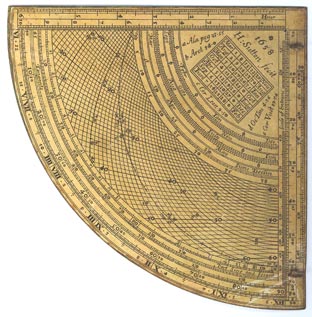Difference between revisions of "Cosmography"
(New page: '''Cosmography''' is the science that maps the general features of the universe; describes both heaven and Earth (but without encroaching on geography or astronomy)...) |
|||
| (3 intermediate revisions by the same user not shown) | |||
| Line 1: | Line 1: | ||
| − | '''Cosmography''' is the science that [[map]]s the general features of the [[universe]]; describes both [[heaven]] and [[Earth]] (but without encroaching on [[geography]] or [[astronomy]]). | + | [[Image:Lighterstill.jpg]][[Image:Suttonquadrant.jpg|right|frame|A Sutton type Quadrant]] |
| + | |||
| + | '''Cosmography''' is the science that [[map]]s the general features of the [[universe]]; describes both [[universe|heaven]] and [[Earth]] (but without encroaching on [[geography]] or [[astronomy]]). | ||
[[Peter Heylyn]]'s [[1652]] book "Cosmographie" (enlarged from his "Microcosmos" of [[1621]]) was one of the earliest attempts to describe the complete world in English being the first known description of [[Australia]] and among the first of [[California]]. The book comprises 4 sections, examining the geography, politics, and cultures of Europe, Asia, Africa, and America, with an addendum on [[Terra Incognita]], including Australia, and extending to [[Utopia]], [[Fairyland]], and the "Land of [[Chivalry|Chivalrie]]". | [[Peter Heylyn]]'s [[1652]] book "Cosmographie" (enlarged from his "Microcosmos" of [[1621]]) was one of the earliest attempts to describe the complete world in English being the first known description of [[Australia]] and among the first of [[California]]. The book comprises 4 sections, examining the geography, politics, and cultures of Europe, Asia, Africa, and America, with an addendum on [[Terra Incognita]], including Australia, and extending to [[Utopia]], [[Fairyland]], and the "Land of [[Chivalry|Chivalrie]]". | ||
| Line 10: | Line 12: | ||
| − | + | [[Category: General Reference]] | |
| − | + | [[Category: Cosmology]] | |
| − | |||
| − | |||
| − | |||
| − | |||
| − | [[Category: | ||
Latest revision as of 20:10, 28 July 2009
Cosmography is the science that maps the general features of the universe; describes both heaven and Earth (but without encroaching on geography or astronomy).
Peter Heylyn's 1652 book "Cosmographie" (enlarged from his "Microcosmos" of 1621) was one of the earliest attempts to describe the complete world in English being the first known description of Australia and among the first of California. The book comprises 4 sections, examining the geography, politics, and cultures of Europe, Asia, Africa, and America, with an addendum on Terra Incognita, including Australia, and extending to Utopia, Fairyland, and the "Land of Chivalrie".
In 1659, Thomas Porter published a smaller but extensive "Compendious Description of the Whole World" which also included a Chronology of world events from Creation forward. These were all part of a major trend in the European Renaissance to explore (and perhaps comprehend) the known world.
The word was commonly used by Buckminster Fuller in his lectures.
The 13th century book 'Aja'ib al-makhluqat wa-ghara'ib al-mawjudat by Persian physician Zakariya al-Qazwini is also considered to be a work of cosmography.
